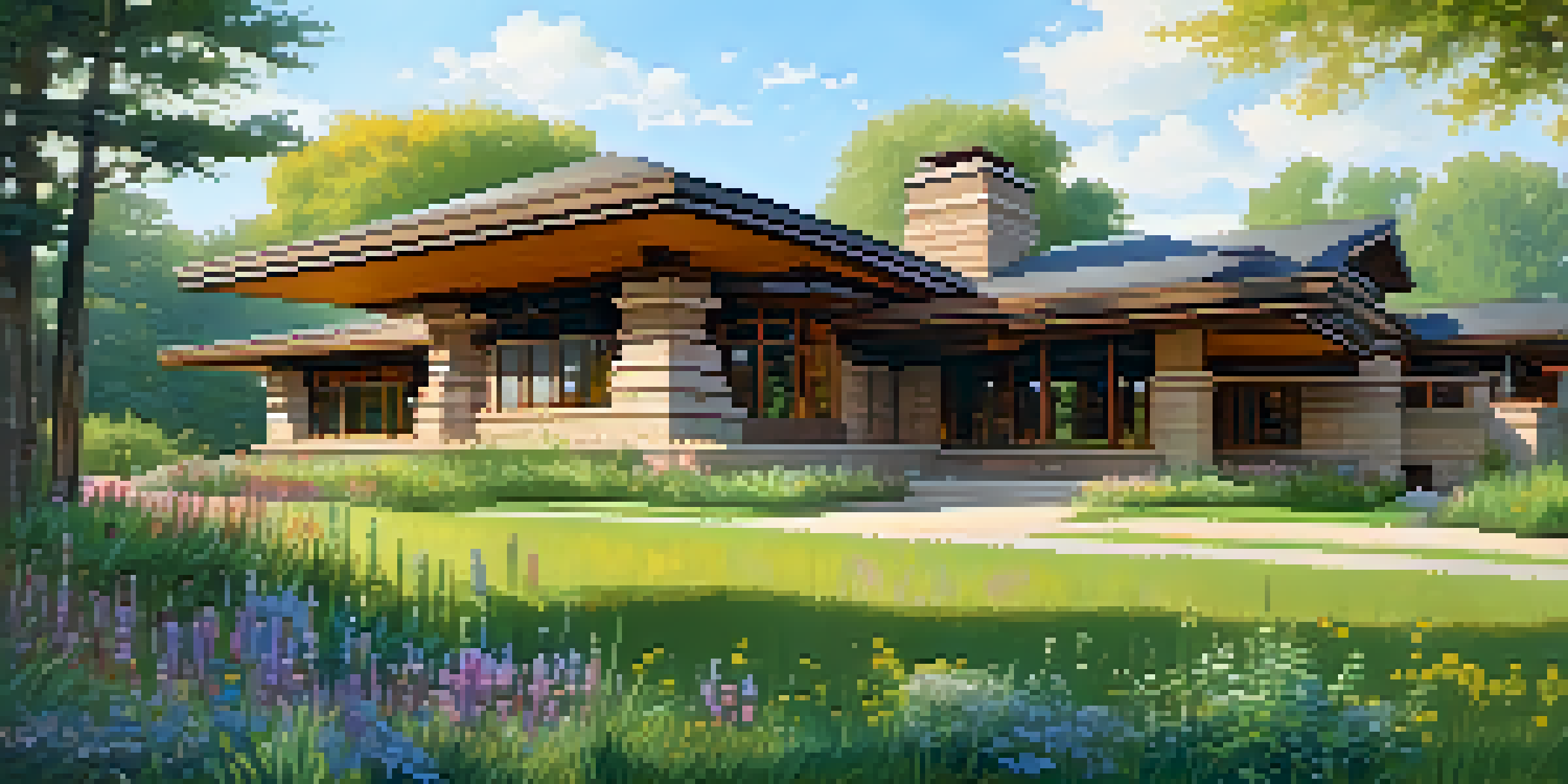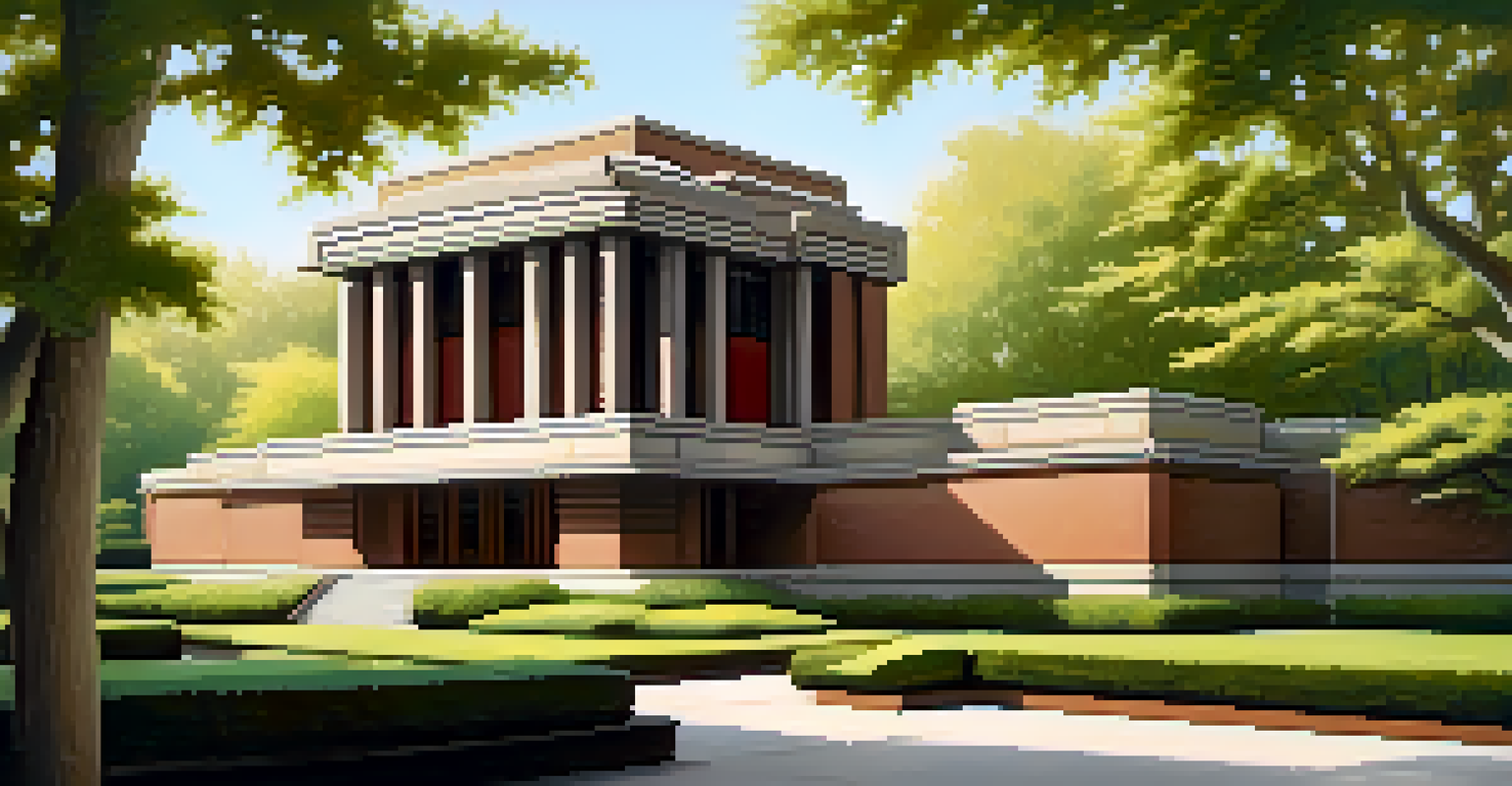Chicago's Prairie School: The Legacy of Frank Lloyd Wright

The Origins of Prairie School Architecture
The Prairie School movement emerged in the early 20th century as a response to the ornate styles of the past. At its core, it sought to create a uniquely American architecture that harmonized with the landscape. Frank Lloyd Wright, a leading figure in this movement, believed buildings should blend seamlessly into their surroundings, reflecting the natural beauty of the Midwest.
The mother art is architecture. Without an architecture of our own, we have no soul of our own civilization.
In Chicago, a city that was rapidly developing at the time, this architectural philosophy found fertile ground. The flat, expansive prairie offered an ideal backdrop for designs that emphasized horizontal lines and open spaces. This movement not only transformed individual homes but also influenced urban planning and community design across the region.
Wright's work, along with that of his contemporaries, established a distinct architectural identity for the Midwest. This focus on simplicity, craftsmanship, and integration with nature set the stage for future architectural innovations. The legacy of the Prairie School continues to resonate in contemporary design, reminding us of the importance of place in architecture.
Frank Lloyd Wright: The Visionary Behind the Movement
Frank Lloyd Wright, born in 1867, became the face of the Prairie School movement through his innovative designs and philosophies. His early work, such as the Robie House in Hyde Park, embodied the principles of the movement with its low-pitched roofs and open floor plans. Wright believed that architecture should not only serve a function but also inspire and uplift the human spirit.

Wright's commitment to craftsmanship was evident in every detail of his buildings, from the materials used to the furniture designed specifically for each space. This holistic approach set his work apart and established a foundation for the Prairie School's aesthetic. His designs often featured natural materials like wood and stone, further emphasizing the connection between the structure and the surrounding environment.
Prairie School's Architectural Roots
The Prairie School movement emerged in the early 20th century, aiming to create uniquely American architecture that harmonizes with the landscape.
As a prolific architect, Wright produced over 1,000 designs, with around half being built. His influence extended beyond residential homes; he also contributed to public buildings and urban planning. This dedication to creating harmonious spaces showcased his vision of architecture as an art form deeply rooted in the American landscape.
Key Characteristics of Prairie School Architecture
Prairie School architecture is easily identifiable by its unique characteristics that reflect the values of the movement. The most prominent feature is the emphasis on horizontal lines, which mimic the flat landscape of the Midwest. This design choice creates a sense of unity with the environment, making the structures appear as if they were an extension of the land.
Space is the breath of art.
Additionally, open floor plans are a hallmark of Prairie School homes, promoting fluidity and connection between spaces. This approach allows natural light to flow freely throughout the interiors, enhancing the overall living experience. Large windows and low ceilings further emphasize this idea of openness, inviting the outside in.
Another defining aspect is the integration of nature, both in the design and materials used. Many Prairie School homes feature built-in furniture, custom light fixtures, and organic motifs that echo the surrounding landscape. This holistic approach ensures that each element of the home works together, creating a cohesive and inviting atmosphere.
Notable Prairie School Structures in Chicago
Chicago is home to several iconic Prairie School buildings that showcase the movement's principles. One of the most notable is the Robie House, designed by Wright in 1910. This masterpiece is celebrated for its innovative use of space and its deep connection to the surrounding landscape, making it a cornerstone of the Prairie School legacy.
Another significant structure is the Unity Temple, also designed by Wright, which highlights his ability to adapt the Prairie style for public use. Completed in 1908, this building features a unique geometric form and stunning interior spaces that foster community and spirituality. Its design reflects Wright's belief that architecture should inspire and uplift those who inhabit it.
Frank Lloyd Wright's Lasting Influence
Frank Lloyd Wright's innovative designs and philosophies established him as the face of the Prairie School, impacting both residential and public architecture.
In addition to Wright's work, other architects from the Prairie School left their mark on Chicago. The work of George Grant Elmslie and William Drummond also contributed to the city's architectural tapestry, with homes that embody the movement's core principles. These buildings serve as a testament to the lasting impact of the Prairie School on Chicago's architectural scene.
The Influence of Prairie School on Modern Architecture
The Prairie School movement laid the groundwork for many modern architectural styles that followed. Its emphasis on simplicity, functionality, and harmony with nature has become a guiding principle for contemporary architects. The movement's principles can be seen in the designs of mid-century modern homes, which also prioritize open spaces and a connection to the outdoors.
Furthermore, the focus on craftsmanship and detail in Prairie School architecture has influenced how modern builders approach construction. Many architects today strive to create spaces that are not only aesthetically pleasing but also functional and sustainable, echoing Wright's vision. This legacy reinforces the idea that architecture should serve the needs of its inhabitants while respecting the environment.
As we look at new developments across the globe, the spirit of the Prairie School lives on. Today's architects continue to draw inspiration from this movement, seeking to create buildings that foster community, enhance well-being, and celebrate the beauty of their surroundings. The lessons of the Prairie School remind us that architecture is not just about buildings; it's about creating meaningful spaces for life.
Preservation Efforts for Prairie School Architecture
As the Prairie School legacy continues to be appreciated, preservation efforts have become increasingly important. Many of Wright's buildings, along with those of his contemporaries, face challenges from urban development and neglect. Organizations and advocates are working tirelessly to ensure these architectural treasures are maintained for future generations.
Restoration projects often require significant resources and expertise, as preserving the original materials and design features is crucial. Community support plays a vital role in these efforts, as local residents often recognize the cultural and historical significance of these structures. By championing preservation, communities can protect their architectural heritage and foster a sense of pride in their unique history.
Preservation of Architectural Heritage
Efforts to preserve Prairie School architecture are vital for maintaining the cultural and historical significance of these iconic structures.
Additionally, educational programs and tours of Prairie School homes are essential for raising awareness about this architectural movement. By sharing the stories behind these buildings, we can inspire a new generation of architects and enthusiasts to appreciate the beauty and importance of Prairie School architecture. The legacy of Frank Lloyd Wright and his contemporaries will continue to thrive as long as we value and protect these remarkable structures.
The Lasting Impact of Chicago's Prairie School Movement
The Prairie School movement has left an indelible mark on the architectural landscape of Chicago and beyond. Its principles of harmony with nature, open spaces, and craftsmanship continue to influence contemporary design. As cities evolve and new architectural trends emerge, the lessons learned from the Prairie School remain relevant and vital.
Wright's vision of architecture as an art form that enhances the human experience resonates in modern sustainable design practices. Architects today are increasingly focused on creating spaces that are not only functional but also promote well-being and connect people to their environment. The enduring legacy of the Prairie School serves as a guiding light for these efforts.

Ultimately, the Prairie School movement is a testament to the power of architecture to shape our lives and communities. By honoring the vision of Frank Lloyd Wright and his peers, we can continue to create spaces that inspire, uplift, and harmonize with the world around us. The legacy of Chicago's Prairie School is not just a chapter in history; it is a vibrant part of our ongoing architectural narrative.